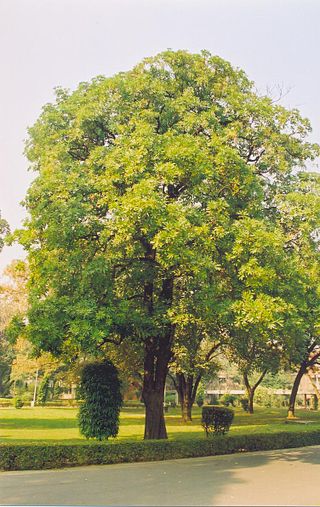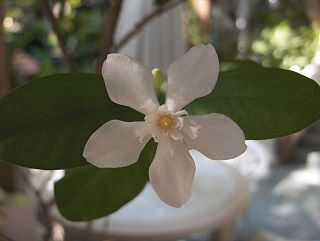
Alstonia is a widespread genus of evergreen trees and shrubs, of the family Apocynaceae. It was named by Robert Brown in 1811, after Charles Alston (1685–1760), professor of botany at Edinburgh from 1716 to 1760.

Trigonostemon is a plant genus of the family Euphorbiaceae and the sole member of its tribe (Trigonostemoneae). It was first described as a genus in 1826. It is native to Southeast Asia, southern China, the Indian Subcontinent, Queensland, and a few islands in the western Pacific.

Aporosa is a genus of flowering plant belonging to the family Phyllanthaceae, first described as a genus in 1825. It is native to China, the Indian Subcontinent, Southeast Asia, Papuasia, and Queensland.

Wrightia is a genus of flowering plants in the family Apocynaceae, first described as a genus in 1810. It native to tropical Africa, China, the Indian Subcontinent, Southeast Asia, Papuasia, and Australia. The species are all small trees or shrubs.

Anodendron is a genus of plant in the family Apocynaceae first described as a genus in 1844. It is native to most of tropical Asia: China, the Indian subcontinent, Southeast Asia, New Guinea, and some islands of the western Pacific.

Kibatalia is a genus of trees and shrubs in the family Apocynaceae, tribe Malouetieae, first described as a genus in 1826. It was initially called Hasseltia, but this turned out to be an illegitimate homonym. So Kibatalia was chosen as a replacement name. Kibatalia is native to China and Southeast Asia.
- Kibatalia arborea(Blume) G.Don – Thailand, Philippines, W Malaysia, Borneo, Sumatra, Java, Sulawesi
- Kibatalia blancoi(Rolfe ex Stapf) Merr. – Philippines
- Kibatalia borneensis(Stapf) Merr. – Sarawak
- Kibatalia elmeriWoodson – Luzon
- Kibatalia gitingensis(Elmer) Woodson – Philippines
- Kibatalia laurifolia(Ridl.) Woodson – Vietnam, Cambodia, Thailand, W Malaysia
- Kibatalia longifoliaMerr. – Mindanao
- Kibatalia macgregori(Elmer) Woodson – Sibuyan
- Kibatalia macrophylla(Pierre ex Hua) Woodson – Yunnan, Indochina
- Kibatalia maingayi(Hook.f.) Woodson – Thailand, W Malaysia, Borneo, Sumatra, Mindanao
- Kibatalia merrillianaWoodson – Leyte, Samar
- Kibatalia puberulaMerr. – Samar in Philippines
- Kibatalia stenopetalaMerr. – Luzon, Dinagat, Mindanao
- Kibatalia villosaRudjiman – W Malaysia, Borneo
- Kibatalia wigmani(Koord.) Merr. – Sulawesi
- Kibatalia africana(Benth.) Merr. = Funtumia africana(Benth.) Stapf
- Kibatalia elastica(Preuss) Merr. = Funtumia elastica(Preuss) Stapf
- Kibatalia latifolia(Stapf) Merr. = Funtumia africana(Benth.) Stapf
- Kibatalia scheffieri(K.Schum.) Merr. = Funtumia africana(Benth.) Stapf
- Kibatalia zenkeri(K.Schum.) Merr. = Funtumia africana(Benth.) Stapf

Kopsia is a genus of plants in the family Apocynaceae. It was first described as a genus in 1823. Kopsia is native to China, Southeast Asia, Australia, and various islands of the western Pacific.

Willughbeia is a genus of plant in the family Apocynaceae, first described as a genus in 1820. It is native to Southeast Asia with a few species in the Indian Subcontinent. Several species have edible fruits enjoyed in many countries. Many species are vines with sticky latex.

Parsonsia is a genus of woody vines in the family Apocynaceae. Species occur throughout Indomalaya, Australasia and Melanesia.

Dyera is a genus of tropical trees up to 80 m in height. They are in family Apocynaceae, native to southeast Asia. It was first described as a genus in 1882, by Joseph Dalton Hooker.

Urceola is a plant genus in the family Apocynaceae, first described as a genus in 1798. It is native to China, the Himalayas, Southeast Asia, and New Guinea.

Cleghornia is a genus of plants in the family Apocynaceae. It includes two species, which are native to Borneo, China, Laos, Malaysia, Sri Lanka, Thailand, and Vietnam.
Tabernaemontana pauciflora is a species of plant in the family Apocynaceae.
Kopsia pauciflora is a tree in the family Apocynaceae. The specific epithet pauciflora means 'few-flowered'.
Chilocarpus is a genus of plant in the family Apocynaceae, first described as a genus in 1823. The genus is native to India, Southeast Asia, and New Guinea.
- Chilocarpus beccarianusPierre - Borneo
- Chilocarpus conspicuus(Steenis) Markgr. - Borneo
- Chilocarpus costatusMiq. - Borneo, Sumatra, W Malaysia, Thailand, Myanmar
- Chilocarpus decipiensHook.f. - Sumatra, W Malaysia
- Chilocarpus denudatusBlume - S India, Nicobar Islands, Indochina, Malaysia, Indonesia, New Guinea
- Chilocarpus hirtusD.J.Middleton - Borneo, Sumatra
- Chilocarpus obtusifoliusMerr. - Borneo, Sumatra, W Malaysia
- Chilocarpus pubescensD.J.Middleton - Borneo
- Chilocarpus rostratusMarkgr. - Borneo, Sumatra, W Malaysia, Thailand
- Chilocarpus sarawakensisD.J.Middleton - Sarawak
- Chilocarpus steenisianusMarkgr. - Borneo
- Chilocarpus suaveolensBlume - Borneo, Sumatra, Java
- Chilocarpus torulosus(Boerl.) Markgr. - Borneo
- Chilocarpus vernicosusBlume - Borneo, Sumatra, W Malaysia
Eucorymbia is a genus of flowering plants in the family Apocynaceae, first described as a genus in 1905. It contains only one known species, Eucorymbia alba, native to Borneo, Sumatra, and peninsular Malaysia.
Micrechites is a genus of flowering plants in the family Apocynaceae, first described as a genus in 1857. It is native to China, the eastern Himalayas, Southeast Asia, Papuasia, and Queensland.

Pottsia is a genus of plants in the family Apocynaceae, first described as a genus in 1837. It is native to East and Southeast Asia.

Spirolobium is a genus of flowering plants in the family Apocynaceae, first described as a genus in 1889. It includes only one known species, Spirolobium cambodianum, native to Southeast Asia.
Micrechites lancifolius is a species of flowering plants in the family Apocynaceae, It is a liana native to Peninsular Malaysia, Borneo, and Sumatra.














